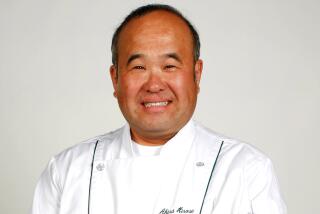‘Being too careful limits your horizons with bonsai.’
- Share via
Every other Saturday morning, the Fuji Bonsai Nursery in Sylmar surrenders its usual serenity to become a laboratory for people taking the fast track to an ancient art form.
It is do-it-yourself day in the world of bonsai.
Bonsai, for those who may not know, is the practice of growing an ordinarily large tree in a small pot.
The art, aside from keeping the tree alive with such scanty foothold, is to trim and shape its branches into an imitation of nature itself, so that the bonsai suggests a tree that has been around for centuries.
If cared for properly by daily watering and a repotting every second or third year, a bonsai can live 100 years or more, creating a living link with past and future generations.
Through a tradition estimated to go back 1,000 years, bonsai follows strict rules of form and procedure and tends to inspire heavy philosophical thoughts.
You needn’t be intimidated by all that, however, during the Saturday morning class at Fuji.
Shigeru Nagatoshi, who learned his art in Japan but brought his nursery to Glenoaks Boulevard in Sylmar 25 years ago, has found a remarkably modern way of sharing the ancient knowledge.
He is served in this by his sons, one of whom, Tom, is in charge of beginners on Saturday.
On my first day, he led about half a dozen novices around the nursery to let each of us choose the plant that we would turn into a bonsai.
“You’re going to take something from over there,” he said, pointing out a bed of perhaps 100 yearling elms in tin pots, “and make it look like that.”
He turned our attention to an elm that stood at the center of a low wooden rack of mature bonsai. It was about two feet tall in a rectangular brown pot. Its bark was cracked with age. Its foliage swept beautifully from the trunk in clusters suspended on twisted branches. Its roots clawed into the moss-encrusted earth.
Tom Nagatoshi sensed our panic. He chuckled.
“I’d say 95% of the bonsai floating around are wrong,” he said. “It doesn’t really matter. It could be an ugly little tree. But, if you did it and it makes you happy, that’s what counts.”
Besides, he said, the young elms had already been pruned and bent by wire into classic bonsai shapes to make it easy for us.
Tom Nagatoshi often chuckled while delivering ad-libbed epigrams to temper the ancient discipline.
“I think any bonsai is ridiculous if it takes more than two people to carry it,” he said at one point, dismissing the genre of monumental bonsai.
I picked out an elm about six inches tall with leaves a quarter of an inch long.
The younger Nagatoshi selected a brown rectangular pot about four inches long.
He pulled the elm out of its tin can. With his fingers he scratched away much of the dirt.
He held the tree over the pot and sprinkled new potting mix over the exposed roots. He put a rock next to the trunk.
Instant bonsai.
He faced a greater challenge in the lace-leafed maple selected by Joyce Silverii, a retired office manager for a Sepulveda elementary school.
It was a delicate plant with several small green trunks and a canopy of leaves.
“First of all, you look for a strong main trunk,” he said, settling his finger on a branch that was not the largest. “Believe it or not, this is it.”
He slid the pruning shears around the base of the largest trunk and snipped it off. A small gasp of horror from his audience faded into admiration. The tree looked better.
“Being too careful limits your horizons with bonsai,” he said. “You’ve got to commit yourself.”
He clipped away more than half the foliage, then wrapped wires around the branches that were left to shape them. He planted it in a shallow, blue oval pot.
Meanwhile, Shigeru Nagatoshi, wearing khaki work clothes, patrolled the work area, moving back and forth among several advanced students.
He would look over their shoulders and offer terse suggestions or point to a branch that should be trimmed or shaped.
“One wire, two branch,” he told a man who was wrapping a fine wire around a pine tree.
He also gave pointers to a man and a woman who had brought six bonsai in an off-road vehicle. They spent the morning standing over them one at a time like barbers, clipping leaves and small branches.
Occasionally, the younger Nagatoshi addressed his father, always in Japanese.
He consulted him on an overgrown azalea brought in by one of the students for potting.
Shigeru Nagatoshi snipped its branches back deftly, then left it for his son to finish.
That day, the elder Nagatoshi spent most of his time with a man of about 45 who was pruning a large, and evidently quite old, California juniper in a wooden box.
They worked silently. The teacher would raise a finger to a branch. The student would cut it. When done, the tree looked naked but elegant. It would leaf out in time.
I approached the man as he lifted the tree into the bed of his pickup truck.
He was Ken Inaba, a Northridge accountant. He had grown up without taking any interest in his father’s bonsai, he said.
Then his father died. Now he’s honoring the link to his past.







